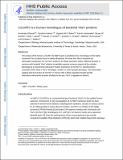| dc.contributor.author | Davies, Bryan W. | |
| dc.contributor.author | Ghosal, Anubrata | |
| dc.contributor.author | Koehrer, Caroline | |
| dc.contributor.author | Babu, Vignesh M.P. | |
| dc.contributor.author | Yamanaka, Kinrin | |
| dc.contributor.author | Jacob, Asha I | |
| dc.contributor.author | Ferullo, Daniel J. | |
| dc.contributor.author | Gruber, Charley C | |
| dc.contributor.author | Vercruysse, Maarten | |
| dc.contributor.author | Walker, Graham C. | |
| dc.date.accessioned | 2018-07-12T19:39:06Z | |
| dc.date.available | 2018-07-12T19:39:06Z | |
| dc.date.issued | 2017-01 | |
| dc.date.submitted | 2017-01 | |
| dc.identifier.issn | 0006-291X | |
| dc.identifier.issn | 1090-2104 | |
| dc.identifier.uri | http://hdl.handle.net/1721.1/116955 | |
| dc.description.abstract | The product of the human C21orf57 (huYBEY) gene is predicted to be a homologue of the highly conserved YbeY proteins found in nearly all bacteria. We show that, like its bacterial and chloroplast counterparts, the HuYbeY protein is an RNase and that it retains sufficient function in common with bacterial YbeY proteins to partially suppress numerous aspects of the complex phenotype of an Escherichia coli ΔybeY mutant. Expression of HuYbeY in Saccharomyces cerevisiae, which lacks a YbeY homologue, results in a severe growth phenotype. This observation suggests that the function of HuYbeY in human cells is likely regulated through specific interactions with partner proteins similarly to the way YbeY is regulated in bacteria. | en_US |
| dc.description.sponsorship | National Institutes of Health (U.S.) (Grant GM31010) | en_US |
| dc.description.sponsorship | National Institutes of Health (U.S.) (Grant GM17151) | en_US |
| dc.publisher | Elsevier | en_US |
| dc.relation.isversionof | http://dx.doi.org/10.1016/J.BBRC.2017.01.149 | en_US |
| dc.rights | Creative Commons Attribution-NonCommercial-NoDerivs License | en_US |
| dc.rights.uri | http://creativecommons.org/licenses/by-nc-nd/4.0/ | en_US |
| dc.source | PMC | en_US |
| dc.title | C21orf57 is a human homologue of bacterial YbeY proteins | en_US |
| dc.type | Article | en_US |
| dc.identifier.citation | Ghosal, Anubrata et al. “C21orf57 Is a Human Homologue of Bacterial YbeY Proteins.” Biochemical and Biophysical Research Communications 484, 3 (March 2017): 612–617 © 2017 Elsevier Inc | en_US |
| dc.contributor.department | Massachusetts Institute of Technology. Department of Biology | en_US |
| dc.contributor.mitauthor | Ghosal, Anubrata | |
| dc.contributor.mitauthor | Koehrer, Caroline | |
| dc.contributor.mitauthor | Babu, Vignesh M.P. | |
| dc.contributor.mitauthor | Yamanaka, Kinrin | |
| dc.contributor.mitauthor | Jacob, Asha I | |
| dc.contributor.mitauthor | Ferullo, Daniel J. | |
| dc.contributor.mitauthor | Gruber, Charley C | |
| dc.contributor.mitauthor | Vercruysse, Maarten | |
| dc.contributor.mitauthor | Walker, Graham C | |
| dc.relation.journal | Biochemical and Biophysical Research Communications | en_US |
| dc.eprint.version | Author's final manuscript | en_US |
| dc.type.uri | http://purl.org/eprint/type/JournalArticle | en_US |
| eprint.status | http://purl.org/eprint/status/PeerReviewed | en_US |
| dc.date.updated | 2018-07-12T13:34:29Z | |
| dspace.orderedauthors | Ghosal, Anubrata; Köhrer, Caroline; Babu, Vignesh M.P.; Yamanaka, Kinrin; Davies, Bryan W.; Jacob, Asha I.; Ferullo, Daniel J.; Gruber, Charley C.; Vercruysse, Maarten; Walker, Graham C. | en_US |
| dspace.embargo.terms | N | en_US |
| dc.identifier.orcid | https://orcid.org/0000-0002-8465-3433 | |
| dc.identifier.orcid | https://orcid.org/0000-0001-5539-4391 | |
| dc.identifier.orcid | https://orcid.org/0000-0003-1777-1082 | |
| dc.identifier.orcid | https://orcid.org/0000-0002-7127-9833 | |
| dc.identifier.orcid | https://orcid.org/0000-0001-7243-8261 | |
| mit.license | PUBLISHER_CC | en_US |
